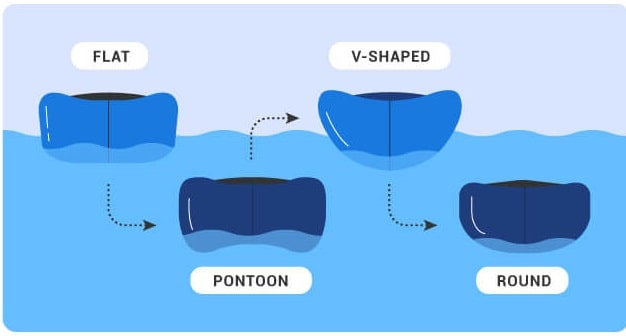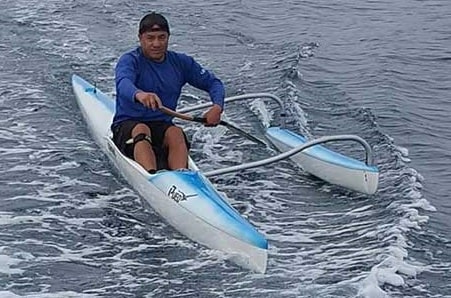For sure, standing in a canoe is paramount to reeling in the line and catching exclusive fish. However, considering the safety, many people just wonder if it’s even possible to maintain their balance on such a seemingly unstable vessel.
In general, you can stand in a canoe in case you’re a pro rider, have a stable watercraft, and stand in just the exact center. It’s because the centerline is the widest yet suitable area to have balance while standing.
Read on to learn more about whether you can stand in a canoe along with some information you would love to know.
Is It Okay to Stand in a Canoe?
Standing in a canoe is not that hard, but it requires a level of expertise and consideration of various factors. These factors include the width of the canoe, the design of its hull, and other aspects that will be explored in more detail.
The placement of your feet and weight distribution play crucial roles when standing in a canoe. Let’s examine them in detail.
As per my experience, Standing in a canoe is only recommended if you’ve ample canoeing experience and can maintain your balance perfectly, But, if you’re a newbie, during choppy water conditions, or when you’re with your family then it isn’t recommended at all, even if you’ve best family canoe and equipment.
How important Foot Placement and Weight Distribution is for standing on Canoe?
Foot placement and weight distribution are some key factors, while standing in a canoe.
Proper weight distribution is required for canoe stability. Aim for a balanced posture by evenly distributing your canoe weight between both feet, avoiding excessive burden on either side of the canoe. Which promotes stability, preventing tilting or capsizing.
Proper foot placement on a canoe is also required for stability and control. Positioning your feet shoulder-width apart establishes a strong foundation that enables quick reactions and balance maintenance, even in unpredictable water conditions.
Key Factors to Consider If You Can Stand in Your Canoe:
When it comes to standing in a canoe, it is affected by some elements. Two elements are discussed above, and some will be discussed below, such as canoe stability, hull design and many more.
Canoe Stability:
Canoes stability is also a vital element, which depends upon types of canoe used. Primary and secondary stability are two important concepts in assessing the stability of a canoe.
Primary stability always refers to the stability of the canoe at rest. Recreational canoes and canoes made for fishing targets primary stability. They are used in calm water and lakes.
Secondary stability always refers to the canoe’s stability while in motion or any external force acting on it. Canoes used in the ocean most often target secondary stability. They are used in the ocean or high-water current areas.
Here’s a quick reminder that even if you’re an expert paddler, still you shouldn’t go for canoeing trip without wearing canoe life jacket and for improved stability, you must wear good-quality canoeing shoes, especially if you intend to paddle while standing up.
Hull Design:
The hull design of a canoe significantly influences its performance and stability while standing. Here are some hull designs and their functions.

· Flat-bottomed Hull:
A hull with a flat bottom provides excellent primary stability, which makes it suitable for clam water activities.
· Pontoon Hull:
The pontoon hull design, characterized by two parallel hulls, provides outstanding stability. Which makes it best for family trips and calm water activities.
· Multi-Chine Hull:
A multi-chine hull design utilizes various angles and changes in the hull’s shape, offering a blend of primary and secondary stability. This versatile design is well-suited for canoes that must navigate different water conditions effectively.
· V-shaped Hull:
V-shaped hull provides outstanding secondary stability, allowing them to cut through water and stability even in high tides and currents. It is mostly used in touring canoes or canoes used in Oceans.
Beam Width:
The width of the canoe at its widest point is known as beam width. Changing beam width impacts its primary and secondary stability.
Greater beam width enhances primary stability, making canoes more suitable for calm water activities like fishing.
On the other hand, a narrow beam width improves secondary stability, making it more suitable for swift turns or rough water/whitewater canoeing.
How wide is a canoe?
For optimal secondary stability, a beam width of 30-40 inches is recommended, while a width of 40 inches or more enhances primary stability.
The choice of beam width depends on the specific water conditions in which the canoe will be used.
Experience:
Experience is invaluable when it comes to standing in canoe, as it enhances stability, especially in challenging conditions.
The more experience you have, the better equipped you are to maintain balance and confidently stand in the canoe, even when facing demanding situations.
As many of the canoeist have installed outboard motors for canoe, then standing up gets more difficult and dangerous due to the increased speed. Also, steering a canoe with outboard motor installed, is very difficult., you never know when your canoe can lose its balance.
Water Conditions and Weather:
Furthermore, Weather and water conditions are crucial factors that greatly influence the ability to stand in a canoe and the overall canoeing experience.
Unfavorable weather and strong wind conditions compromise stability, making canoeing difficult and challenging.
Moreover, unpredictable and turbulent water conditions pose considerable challenges for canoeing.
Failing to handle these conditions with care can result in canoe capsizing.
Outriggers:
How to stabilize a canoe?
When it comes to stabilizing your canoe, outriggers prove to be an ideal solution.
Attaching outriggers to the sides of the hull expands the surface area, enhancing stability and preventing capsizing when standing in canoe.
What is an outrigger canoe?
The watercraft comes equipped with built-in outriggers to enhance safety during canoeing in challenging conditions.

Now! We will discuss some essential tips while standing in the canoe.
Key Tips for Standing in Canoe:
To ensure safety and stability while standing in a canoe, it is important to follow key guidelines and tips. Here are some vital tips to keep in mind when standing in canoe:
Make Sure Your Legs Are Strong:
To stand in a canoe, it is essential to have strong legs as canoeing relies heavily on leg involvement. Insufficient leg strength can lead to instability and potential falls.
Making your legs strong through exercise and active engagement will make your balance more stable.
Make Sure the Canoe is Stable:
Before attempting to stand in a canoe, it is crucial to know its stability. There are many methods for confirming a canoe’s stability.
However, a straightforward way to evaluate a canoe’s stability is by gently tilting it from side to side. If the canoe easily loses balance and tilts excessively, it signifies a lack of stability. There are some canoe models which are known for their stability over the water currents, such as Sea Eagle Inflatable 16’ Canoe and even freighter canoes are much stable as they’re weight carrying vessels.
Find the Stable Point:
For standing easily in a canoe, you will need to find the most stable point in the whole canoe. Mostly they lie near the center of the canoe.
How to determine the stable point on a canoe?
Sit in different locations and shift your weight forward and backward. Identify the position where you feel the greatest stability, indicating the stable point.
Your Legs are wide as Your Shoulder Width:
To enhance stability while in a standing canoe, widen your leg stance to match the width of your shoulders.
Aligning your leg width with your shoulder width in a canoe creates a sturdy foundation, evenly distributing your weight and reducing the risk of leaning or tipping.
Bend Your Knees:
Maintaining bent knees while standing in canoe enhances stability and balance.
Bending your knees lowers your center of gravity, improving stability by absorbing the movements and forces encountered while in a standing canoe.
Slowly Stand Up:
When you have identified the stable point, proceed to stand up gradually and with caution.
Standing up slowly and cautiously in a canoe reduces the risk of falling and capsizing, allowing for a gradual and controlled shift in weight.
If you feel like you might lose your balance while standing in a canoe, simply sit down and take your time to regain stability and feel secure again.
Keep Balance:
Once you have stood up in the canoe, it is crucial to actively maintain your balance.
If you feel like you might lose your balance while standing in a canoe, simply sit down and take your time to regain stability and feel secure again.
Slowly Sit Down:
To safely transition from a standing position to sitting in a canoe, it is important to do so gradually and with caution.
Begin by bending your knees and carefully lowering yourself into a stable seating position, utilizing your hands for added support to prevent any sudden falls or loss of balance.
How is standing on a canoe more adventurous and what benefits does it offer?
Standing in a canoe offers a more adventurous experience, which offers multiple benefits such as:
1. More clear visibility.
2. Explore shallow water areas.
3. Makes activities like fishing and photography easier.
Can You Stand Up in a Canoe And Fish?
Specialized fishing canoes are designed to prioritize stability while standing, although this may come at the expense of speed.
When engaging in stand-up fishing, two important points should be kept in mind.
1. Position yourself as close to the centerline as possible, it maximizes stability and minimizes risk of fall.
2. Shifting one foot forward while standing in a canoe enhances stability, absorbs shocks, and prevents falls, resulting in improved balance, control, and accuracy for activities like fishing.
How to Get in and Out of a Canoe:
Mastering the technique of getting in and out of a canoe is a vital skill that requires careful consideration and practice.
Below are some steps for entering and exiting a canoe easily.
1. Firstly, to facilitate easy entry, align yourself at the side of the canoe, ensuring optimal stability.
2. Now, begin by lowering your one knee, for a more controlled and balanced transition for entering the canoe.
3. Gradually place your second leg in the canoe, ensuring a gradual and controlled movement to prevent falls or loss of balance.
4. Start shifting your weight to a seated position, for more safety and comfort of entering a canoe.
5. Gently and smoothly swing your legs into the canoe, taking care to perform the movement in a controlled manner. This will help you sit comfortably.
6. Last but not least, for exiting smoothly and gradually reverse these steps, for safe exit.
What should you not do in a Canoe While standing?
To maintain a comfortable ride while standing in a canoe, it is advisable to avoid certain movements such as:
- Avoid sudden movements which can disrupt stability and balance.
- Wear Personal Flotation Devices (PFD) while standing in a canoe, which will be helpful when the canoe is capsized.
- Don’t lean too far to the side of the canoe, this can tip your canoe over.
- Prevent overestimating your ability, if you are uncomfortable so sit down without taking any risk.
- Maintain safety measures, don’t ignore them, and also watch out for obstacles, they give much damage to your canoe.
- Also watch for which canoe is most stable for certain water conditions you are visiting.
Conclusion – Can you stand up in the canoe
However, standing in a canoe is dangerous. It involves risk but handling it gently will make your experience fascinating.
- Choose a specific hull design according to water conditions near you, and also keep primary and secondary stability in your mind.
- Following tips for standing in a canoe and precautions for it will surely benefit you.
- Standing in a canoe is a challenge in itself, it carries inherent risks, but approaching it with caution and gentleness can make the experience truly captivating.
FAQ
Is Standing in a Canoe recommended for beginners?
Standing in a canoe is generally not recommended for beginners due to the increased risk of instability and potential accidents. It is advisable to gain experience and develop proper balance and canoe paddling skills before attempting to stand.
Can You Move Around The Canoe?
Yes, you can move around the canoe while seated or kneeling, but it is important to do so with caution and maintain a balanced weight distribution to avoid tipping over.
What can happen if I keep on standing in the canoe?
Continuing to stand on a canoe without proper balance or control can lead to a loss of stability, causing the canoe to tip over easily. However, it is also important to practice righting a capsized canoe before you start paddling in a canoe.
How do I practice balance without getting hurt or wet?
It is recommended to start by kneeling or sitting. Gradually shift your weight and practice small movements while maintaining stability and control before attempting to stand.
Are there specific canoes designed for standing?
Yes, there are canoes specifically designed for standing, such as stand-up paddleboard (SUP) canoes or specialized fishing canoes.
Are there any weight or size limitations for standing on a canoe?
Weight and size limitations can vary depending on the specific canoe’s design and construction.
Can I paddle while standing on a canoe?
Yes, it is possible to paddle while standing on a canoe. However, this requires a higher level of balance and skill. It is recommended to practice standing and paddling in calm and controlled water conditions.

Jack Bennett, a passionate pedal boating enthusiast, and marine engineer by day, is here to share my knowledge and love for this exciting sport with you all. Happy Boating!
